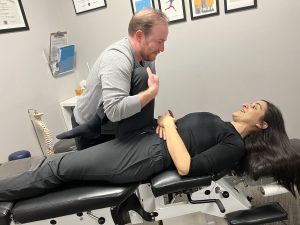Osteopathy
Treatment is not technique based, and is grounded in an extensive understanding of anatomy and physiology and the principles of osteopathy that the body is a dynamic unit of function, the body is self healing and self regulating, and structure and function are reciprocally interrelated. Treatment may involve the application of myofascial release, neuromuscular activation, gentle joint manipulation, and gentle visceral manipulations.
Manual osteopathy may help with general aches and pains, neck and back pain, sleep trouble, migraines and headaches, digestive issues, post surgery recovery, and a multitude of other scenarios.
Delivering long-term results to dysfunction and pain goes beyond understanding the symptoms. With highly sensitive palpation skills and a detailed understanding of anatomy, your practitioner will begin each treatment with a full body assessment. Locating the root cause of an issue rather than only treating the presenting pain or symptoms is at the heart of osteopathic treatment, and what is treated may not align with where you are feeling pain. For example – shoulder pain could stem from the shoulder itself, or, because the body is a dynamic unit of function it could be rooted elsewhere in the body, like the ankle or hip. Treatment includes application of gentle manipulation, and coordinating changes with the rest of the body so it can adapt to treatment as effectively as possible.
Treatment begins by progressively unloading larger lines of tension, and ensuring the body is globally realigned. As the course of treatment progresses your practitioner will dive deeper into more specific areas of restriction, working locally in the given region. Finally, the smaller and more focused areas of dysfunction can be addressed. Through this approach, osteopathy assesses all layers of the body from superficial to deep, depending on the individual’s needs. After treatment the body must adjust to these changes, which takes time. Changes from treatment can be felt immediately, or may take 3-5 days to integrate. The path to health is not always a straight line and injuries or setbacks can occur, as such the treatment prescription is adaptable to what the individual needs at all times. It is also important to note that older injuries and dysfunctions can take more time to resolve, as the body has adapted and compensated for them over time and will require more treatments.
